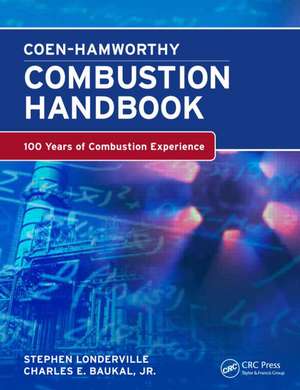The Coen & Hamworthy Combustion Handbook: Fundamentals for Power, Marine & Industrial Applications: Industrial Combustion
Editat de Stephen Londerville, Charles E. Baukal Jr.en Limba Engleză Hardback – 25 mar 2013
A Refresher in Fundamentals and State-of-the-Art Solutions for Combustion System Problems
Roughly divided into two parts, the book first reviews combustion engineering fundamentals. It then uses a building-block approach to present specific computations and applications in industrial and utility combustion systems, including those for
- Transport and introduction of fuel and air to a system
- Safe monitoring of the combustion system
- Control of flows and operational parameters
- Design of a burner/combustion chamber to achieve performance levels for emissions and heat transfer
- Avoidance of excessive noise and vibration and the extension of equipment life under adverse conditions
Practical Computations and Applications for Industrial and Utility Combustion Systems
A ready reference and refresher, this unique handbook is designed for anyone involved in combustion equipment selection, sizing, and emissions control. It will help you make calculations and decisions on design features, fuel choices, emissions, controls, burner selection, and burner/furnace combinations with more confidence.
Preț: 1428.78 lei
Preț vechi: 1908.33 lei
-25% Nou
Puncte Express: 2143
Preț estimativ în valută:
273.42€ • 283.73$ • 228.54£
273.42€ • 283.73$ • 228.54£
Comandă specială
Livrare economică 22 februarie-08 martie
Doresc să fiu notificat când acest titlu va fi disponibil:
Se trimite...
Preluare comenzi: 021 569.72.76
Specificații
ISBN-13: 9781439873335
ISBN-10: 143987333X
Pagini: 561
Ilustrații: 390 color images and 87 tables
Dimensiuni: 210 x 280 x 30 mm
Greutate: 1.81 kg
Ediția:New.
Editura: CRC Press
Colecția CRC Press
Seria Industrial Combustion
ISBN-10: 143987333X
Pagini: 561
Ilustrații: 390 color images and 87 tables
Dimensiuni: 210 x 280 x 30 mm
Greutate: 1.81 kg
Ediția:New.
Editura: CRC Press
Colecția CRC Press
Seria Industrial Combustion
Public țintă
Practicing engineers, technicians, technical managers, researchers, vendors, consultants, and government regulators working in industrial, marine, and utility combustion; graduate students taking advanced courses in combustion.Cuprins
Introduction. Engineering Fundamentals. Combustion Fundamentals. Fuels. Oil Atomization. Solid Fuel Combustion in Suspension. Heat Transfer. Fundamentals of Fluid Dynamics. CFD-Based Combustion Modeling. Pollutant Emissions. Noise. Combustion Controls, Burner Management, and Safety Systems. Blowers for Combustion Systems. Burners and Combustion for Industrial and Utility Boilers. Duct Burners. Air Heaters. Marine and Offshore Applications. Appendices. Index.
Notă biografică
Stephen B. Londerville is currently chief engineer at Coen Company, San Mateo City, California. He has previously served as chief technical officer since 1978 at Coen, vice president R&D, director R&D, and chief engineer. During the past 35 years, he has been involved with all aspects of product development at Coen Company. He holds seven patents and has authored 16 publications. He is a member of ASME, ACHIE, the Combustion Institute, Tau Beta Pi, and the Institute for Liquid Atomization and Spray Systems (ILASS) and was past officer in the board of directors at ILASS. He was recognized as Engineer of the Year by ASME, Santa Clara Valley Section.
Charles E. Baukal, Jr., Ph.D., PE, is the director of the John Zink Institute for the John Zink Company, LLC (Tulsa, Oklahoma), where he has been since 1998. He has more than 30 years of experience in the fields of industrial combustion, pollution control, and heat transfer and has authored more than 150 publications in those areas. Dr. Baukal serves as an adjunct instructor at Oral Roberts University, the University of Oklahoma, the University of Tulsa, and the University of Utah. He is also a member of the American Society of Mechanical Engineers, the American Society for Engineering Education (ASEE), and the Combustion Institute.
Charles E. Baukal, Jr., Ph.D., PE, is the director of the John Zink Institute for the John Zink Company, LLC (Tulsa, Oklahoma), where he has been since 1998. He has more than 30 years of experience in the fields of industrial combustion, pollution control, and heat transfer and has authored more than 150 publications in those areas. Dr. Baukal serves as an adjunct instructor at Oral Roberts University, the University of Oklahoma, the University of Tulsa, and the University of Utah. He is also a member of the American Society of Mechanical Engineers, the American Society for Engineering Education (ASEE), and the Combustion Institute.
Recenzii
"I consider that the main strength of this book is the elaboration of both ... the theoretical and practical, to make it of great interest and relevance to practicing engineers. The language is simple and the arrangement of chapters is good, moving from theory to practice progressively. Besides various types of burners, all the associated equipment like fans, furnaces, controls, and safeties are all covered, making the topic complete. ... Designers, operators, consulting engineers and also students of heat power should find this book extremely useful."
—Kumar Rayaprolu, author of Boilers: A Practical Reference and Boilers for Power and Process
—Kumar Rayaprolu, author of Boilers: A Practical Reference and Boilers for Power and Process
Descriere
Sharing the knowledge of top combustion engineers and technologists from the Coen Company and John Zink Hamworthy Combustion, this unique handbook provides practical guidance to help you make decisions about fuels, burners, and combustion chambers for combustion systems. It begins with the necessary combustion engineering fundamentals and then uses a building-block approach to tackle specific computations and applications in industrial, marine, and utility combustion systems. A handy reference and refresher, it is designed for anyone involved in combustion equipment selection, sizing, and emissions control.


